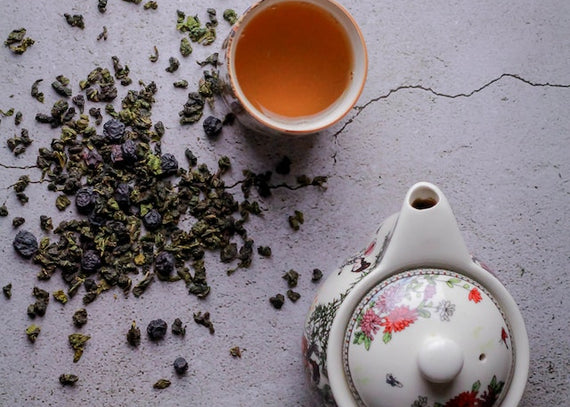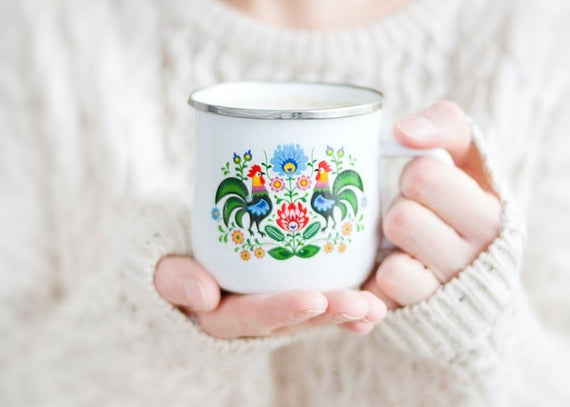There may be no other country on Earth that has as many different variations, styles, and types of green tea as China. With many famous varieties coming from Hubei, Anhui, Yunnan, and Fujian among others, Chinese green tea boasts all the same health benefits and calming effects on the mind as green tea from other countries, but with the distinction of offering us something more. That something more is the different, unique, and dynamic flavours, aromas, traditions, and culture of each type of tea. You cannot get the same effect from a bag of green tea bought at any store in a cardboard box. Chinese teas range in rarity and have identities all their own. The terroir and regions of China are very diverse, and every type of tea leaf reflects this down to its stems. Bon Tea offers many exquisite and healthy Chinese green teas. Two, in particular, are the Dragon Well and Jasmine Green tea. Two delicious, healthy and dynamic leaf varieties.
A mythic name for a truly otherworldly tea, dragon-well is the translation of its original Chinese title, Long-Jin. This tea is one of the most famous green teas in all of China. It was used for the Imperial tribute during China's Qing dynasty. The imperial family had a tradition of enjoying this tea during the summer months, and then in the winter, they would switch to the fermented pu'erh. The origin place of this tea was in Hangzhou city, but today it is produced all over China. Each region has a different take on Long Jing, and so the variety of the flavours are diverse and nuanced depending on the region. This tea is harvested in early spring, withered on bamboo trays and then often pan or wok-fried. While undergoing the tea processing, the tea master will use hand movements to shape and flatten the leaves into the distinct flat shape Dragon Well leaves comes in. Within the Dragon Well tea category, there are two main styles. One style features more yellow leaves that possess a roasted flavour and undergo hand pressing. The other style features greener leaves that can have a lighter or nuttier flavour. The liquor of this legendary tea often has a yellow-orange hue and is reminiscent of sunshine. The leaves themselves are well worked and can also offer a mellow, yet spicy flavour. Moreover, don't forget the health benefits of greens like Dragon Well, including tons of antioxidants and immune-boosting properties.
Scented teas like jasmine were first invented during China's Tang dynasty. During this time, the tea would be pressed and scented with various herbs to give it a pleasant aroma. During the Song dynasty tea culture experienced some shifts; first, it was the shift to enjoy pure tea with no additional ingredients. However, then in the latter part of the Song dynasty, scented tea came back into vogue. This time with osmanthus and jasmine blossoms. This style of scented tea originated in Guangdong province. Over time, scented teas were added to tea records and texts and included flowers like rose and gardenia.
Jasmine blossoms reportedly imported to China from Central Asia during the Jin dynasty, were initially used in medicinal contexts. Jasmine, according to traditional Chinese Medicine, is neither "cooling" nor "warming" but somewhat balanced and helps to harmonize the body's internal vital energy or "chi." It was for these reasons jasmine was often prescribed to treat sore muscles and dry skin. By the 1800s jasmine tea was very popular in northern China, where the scent of the tea maintained even during the long transit from southern China up north. Today, provinces like Sichuan, Guangxi, and Fujian are all major jasmine tea production centers. To make scented blends like jasmine, the finished tea leaves are combined with fresh blossoms. This way as much aroma can be absorbed into the tea leaves for 2-3 weeks. The flowers are replaced by fresh blossoms every so often and then are finally removed before the tea is packed to be ready for retail. The health benefits of jasmine go back to traditional Chinese Medicine's teachings that jasmine can relieve blood vessels around the eyes and aid in muscle relaxation and harmonizing the body's chi. Jasmine tea has a sweet and floral aroma, a deep amber colour and a rich, bold flavour.
History
The origins of tea culture in China are said to go back 5000 years. Green tea was the first tea enjoyed in ancient Chinese culture, having been developed long before black or Oolong, which only go back around 500 years ago. Moreover, today, it is still regarded as the supreme tea in China. There are thousands of different kinds and varieties of green tea in China and more from around the globe. However, Chinese teas still maintain their place as not just the first but also the finest of teas. Green tea is produced from the newest and sweetest of the tea buds. They are plucked from the top of the tea plant, and the finest of tea types are only harvested during springtime. While black, Oolong and Pu'erh tea are all oxidized for a time, green tea is not. Green tea varieties differ from one another in regards to the leaves that are chosen, as well as how and in what ways the leaves are plucked. Historically, it was a tradition that spring could not officially start until the Emperor of China enjoyed the finest of teas.
Even today, the first, and most exquisite spring buds are the most prized and at various points in history were more highly prized and coveted than gold. Before the Ming dynasty, which lasted from the late 1300s until the mid-1600s, green tea was compressed into tea cakes. Some teas like Pu'erh are still processed and packaged this way. However, it was also during the Ming dynasty when loose leaf tea culture began and is a tradition that has continued into the modern era. In East Asia, specifically China, Korea, and Japan, green tea is given as a gift and represents long health and longevity. Two things you are guaranteed when you enjoy green tea.
One of the most studied of all the tea types
Tea's role as a health-enhancing beverage has been antiquated knowledge in China and Japan for ages. Within the past 30 years, Japanese researchers had paid particular interest to the effects of tea consumption on health when people began to ask why the Okinawa people live in such old age and had such low rates of cancer. Enjoying tea, especially green and jasmine, are traditions in Okinawa passed down from the islands' long history as a trading partner in the tributary system of Imperial China. As it turns out, part of the Okinawa people's longevity and good health comes from their tea habits. Studies have found Green tea to be an incredibly beneficial drink that can combat heart disease, diabetes, and many other health issues while also providing a score of health benefits. The positive results of studying tea keep yielding more promising results!
Have you ever heard of EGCG?
Tea harbours a heavy dose of polyphenols, which are a type of antioxidant. One, in particular, Epigallocatechin gallate or EGCG is very useful in helping to prevent certain types of cancer. Tea that is produced from juvenile, unopened tea leaves, also known as buds or tips, has a very high amount of EGCG.
In regards to other health benefits, in traditional Chinese Medicine, green tea is believed to be useful as a "cooling" agent for our body. Illnesses brought about by having too much "heat" in the body can be ameliorated by the cooling properties of green tea. In contrast to more oxidized teas like black and pu'erh, green tea is not oxidized and thus causes more of a cooling effect than oxidized teas do, moreover, just like all things, the higher the quality, the better the results. The same goes for tea; the higher quality tea is more beneficial for our overall improved health. It is also believed that green tea should be consumed undivided so that all of its constituent nutrients can harmonize and grant better benefits to our health.
Other varieties of Chinese Green Tea
Beginning sometime during the Southern Song dynasty, loose-leaf green tea became the favoured tea in China. During the Ming dynasty, a shift happened, from steaming the leaves, a process still practiced in Japan, to pan-frying them in a dry wok, oven or basket firing the leaves, tumble drying and sun-drying them. Befitting its status as the favoured tea of China, green tea is also the most widely produced of Chinese teas. In 2014 China produced 1.42 million tons of tea. This gives a much more substantial meaning to the phrase, "for all the tea in China." There are many exquisite green teas from China, here are some of particular note:
Biluochun Produced in Jiangsu, this tea is named after the shape of the leaves, which are curled like snails.
Chun Mee Known in English by its Cantonese name, and famous outside China. It has a plum-like flavour.
Gunpowder Tea A tea which is tumble-dried so that each leaf is rolled into a small pellet that resembles gunpowder.
Huangshan maofeng A type of maofeng tea grown in the microclimate of the Huangshan mountain range in Anhui province. Maofeng teas are harvested by plucking intact two equal-sized leaves and a bud together.
Longjing is also known as "Dragon Well" tea. Grown near Hangzhou in Zheijiang province, Longjing is the most well-known pan-fired Chinese green tea. Its flavour derives partly from the terroir of the region in which it is produced.
Lu'an Melon Seed Grown in Anhui province. Unlike typical Chinese teas, two leaves are plucked separately from each branch, with no bud and no stems. Harvested later in the season, it has a grassier flavour than typical Chinese green teas.
Taiping Houkui Grown in Anhui province, uses a cultivar with an unusually large leaf. The production process flattens the tea leaves, creating the so-called "two knives and a pole" shape from the leaves and stem.
Xingyang Maojian A type of maojian tea grown in Xingjiang, Henan province. Maojian teas are harvested by plucking a bud and one leaf together.




